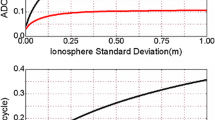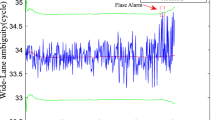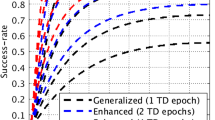Abstract
With the popularity of global navigation satellite system (GNSS) applications, how to tackle the cycle slips under complex observation conditions is inevitable. Here, the complex observation condition means that one may face the challenges of harsh environment, single-frequency low-cost receiver, or real-time kinematic situation, etc. However, most currently existing cycle slip detection and repair methods are designed for specific scenarios, and little attention has been paid to the unified method, which limits the availability, precision and reliability of cycle slip processing, especially under complex observation conditions. This paper is the first to systematically and comprehensively study the principles, methods and applications of cycle slip detection and repair under complex observation conditions. Firstly, one unified method of cycle slip processing is proposed, which mainly has three aspects. Specifically, the geometry-free (GF), geometry-based (GB), and geometry-fixed (GFix) models are designed for the geometric term; the ionosphere-free, ionosphere-unbiased, and ionosphere-biased models are designed for the ionospheric delay; the observation-domain (OD)-, state-domain (SD)-, and coordinate-domain (CD)-aided approaches are used to assist the cycle slip processing. Secondly, three practical cycle slip processing methods are also proposed based on the above unified method, focusing on three typical complex observation conditions. They are the SD-aided GFix method, OD- and CD-aided GB method, and GF combined GB method. Three experiments were conducted and analyzed in detail to validate the effectiveness of these proposed methods. The results show that the unified method is feasible and superior, and the three new specific methods can detect and repair the small, multiple, and insensitive cycle slips better than the traditional methods under complex observation conditions. Typically, when applying the proposed methods, the success rate of ambiguity resolution can be improved by approximately 39%, and centimeter-level and millimeter-level positioning accuracy can be obtained in RTK and PPP.

















Similar content being viewed by others
Data availability
The experimental data of this study are available from the corresponding author for academic purposes on reasonable request.
References
Banville S, Langley R (2009) Improving real-time kinematic PPP with instantaneous cycle-slip correction. Proc ION GNSS 2009:2470–2478
Banville S, Langley R (2013) Mitigating the impact of ionospheric cycle slips in GNSS observations. J Geod 87:179–193
Blewitt G (1990) An automatic editing algorithm for GPS data. Geophys Res Lett 17:199–202
Cai C, Liu Z, Xia P, Dai W (2013) Cycle slip detection and repair for undifferenced GPS observations under high ionospheric activity. GPS Solut 17:247–260
Carcanague S (2012) Real-time geometry-based cycle slip resolution technique for single-frequency PPP and RTK. Proc ION GNSS 2012:1136–1148
Chen D, Ye S, Zhou W et al (2016) A double-differenced cycle slip detection and repair method for GNSS CORS network. GPS Solut 20:439–450
de Lacy M, Reguzzoni M, Sansò F, Venuti G (2008) The Bayesian detection of discontinuities in a polynomial regression and its application to the cycle-slip problem. J Geod 82:527–542
Han S (1997) Carrier phase-based long-range GPS kinematic positioning. Ph.D. thesis, The University of New South Wales
Hatch R (1982) The synergism of GPS code and carrier measurements. In: Proceedings of the 3rd international geodetic symposium on satellite doppler positioning, pp 1213–1231
Hofmann-Wellenhof B, Lichtenegger H, Wasle E (2007) GNSS—global navigation satellite systems: GPS, GLONASS, Galileo, and more. Springer
Lee H, Wang J, Rizos C (2003) Effective cycle slip detection and identification for high precision GPS/INS integrated systems. J Navig 56:475–486
Leick A, Rapoport L, Tatarnikov D (2015) GPS satellite surveying. Wiley
Li B, Shen Y, Feng Y et al (2014) GNSS ambiguity resolution with controllable failure rate for long baseline network RTK. J Geod 88:99–112
Li B, Li Z, Zhang Z, Tan Y (2017) ERTK: extra-wide-lane RTK of triple-frequency GNSS signals. J Geod 91:1031–1047
Li B, Zhang Z, Shen Y, Yang L (2018) A procedure for the significance testing of unmodeled errors in GNSS observations. J Geod 92:1171–1186
Li B, Liu T, Nie L, Qin Y (2019a) Single-frequency GNSS cycle slip estimation with positional polynomial constraint. J Geod 93:1781–1803
Li B, Qin Y, Liu T (2019b) Geometry-based cycle slip and data gap repair for multi-GNSS and multi-frequency observations. J Geod 93:399–417
Li P, Jiang X, Zhang X et al (2019c) Kalman-filter-based undifferenced cycle slip estimation in real-time precise point positioning. GPS Solut 23:99
Li Q, Dong Y, Wang D et al (2021) A real-time inertial-aided cycle slip detection method based on ARIMA-GARCH model for inaccurate lever arm conditions. GPS Solut 25:26
Lipp A, Gu X (1994) Cycle-slip detection and repair in integrated navigation systems. In: Proceedings of 1994 IEEE position, location and navigation symposium-PLANS’94. IEEE, pp 681–688
Liu Z (2011) A new automated cycle slip detection and repair method for a single dual-frequency GPS receiver. J Geod 85:171–183
Melbourne W (1985) The case for ranging in GPS-based geodetic systems. In: Proceedings of the first international symposium on precise positioning with the Global Positioning System, pp 373–386
Montenbruck O, Steigenberger P, Hauschild A (2015) Broadcast versus precise ephemerides: a multi-GNSS perspective. GPS Solut 19:321–333
Montenbruck O, Steigenberger P, Prange L et al (2017) The Multi-GNSS Experiment (MGEX) of the International GNSS Service (IGS)–achievements, prospects and challenges. Adv Space Res 59:1671–1697
Odijk D (2000) Weighting ionospheric corrections to improve fast GPS positioning over medium distances. Proc ION GPS 2000:1113–1123
Shi C, Gu S, Lou Y, Ge M (2012) An improved approach to model ionospheric delays for single-frequency precise point positioning. Adv Space Res 49:1698–1708
Teunissen P (1995) The least-squares ambiguity decorrelation adjustment: a method for fast GPS integer ambiguity estimation. J Geod 70:65–82
Teunissen P (1998) Success probability of integer GPS ambiguity rounding and bootstrapping. J Geod 72:606–612
Teunissen P, Khodabandeh A (2021) A mean-squared-error condition for weighting ionospheric delays in GNSS baselines. J Geod 95:118
Teunissen P, Montenbruck O (2017) Springer handbook of global navigation satellite systems. Springer
Verhagen S, Li B, Teunissen P (2013) Ps-LAMBDA: ambiguity success rate evaluation software for interferometric applications. Comput Geosci 54:361–376
Wang N, Li Z, Huo X et al (2019) Refinement of global ionospheric coefficients for GNSS applications: Methodology and results. Adv Space Res 63:343–358
Wübbena G (1985) Software developments for geodetic positioning with GPS using TI 4100 code and carrier measurements. In: Proceedings of the 1st international symposium on precise positioning with the Global Positioning System, pp 403–412
Xiao G, Mayer M, Heck B et al (2018) Improved time-differenced cycle slip detect and repair for GNSS undifferenced observations. GPS Solut 22:6
Xu P, Shi C, Liu J (2012) Integer estimation methods for GPS ambiguity resolution: an applications oriented review and improvement. Surv Rev 44:59–71
Yang Y, Mao Y, Sun B (2020) Basic performance and future developments of BeiDou global navigation satellite system. Satell Navig 1:1
Zhang X, Li X (2012) Instantaneous re-initialization in real-time kinematic PPP with cycle slip fixing. GPS Solut 16:315–327
Zhang X, Li P (2016) Benefits of the third frequency signal on cycle slip correction. GPS Solut 20:451–460
Zhang Z, Li B, He X et al (2020) Models, methods and assessment of four-frequency carrier ambiguity resolution for BeiDou-3 observations. GPS Solut 24:96
Zhang Z, Yuan H, Li B et al (2021) Feasibility of easy-to-implement methods to analyze systematic errors of multipath, differential code bias, and inter-system bias for low-cost receivers. GPS Solut 25:116
Zhao J, Hernández-Pajares M, Li Z et al (2020) High-rate Doppler-aided cycle slip detection and repair method for low-cost single-frequency receivers. GPS Solut 24:80
Acknowledgements
This work was supported by the National Natural Science Foundation of China (42004014), the Natural Science Foundation of Jiangsu Province (BK20200530).
Author information
Authors and Affiliations
Contributions
ZZ proposed the methods, derived the formulae, designed the experiments, and wrote and revised the paper. JZ worked out the technical details, and revised the paper. BL supervised the study, and modified the original manuscript. XH contributed to the final version of the manuscript. All authors approved of the manuscript.
Corresponding author
Ethics declarations
Conflict of interest
The authors have no competing interests to declare that are relevant to the content of this article.
Rights and permissions
Springer Nature or its licensor (e.g. a society or other partner) holds exclusive rights to this article under a publishing agreement with the author(s) or other rightsholder(s); author self-archiving of the accepted manuscript version of this article is solely governed by the terms of such publishing agreement and applicable law.
About this article
Cite this article
Zhang, Z., Zeng, J., Li, B. et al. Principles, methods and applications of cycle slip detection and repair under complex observation conditions. J Geod 97, 50 (2023). https://doi.org/10.1007/s00190-023-01743-z
Received:
Accepted:
Published:
DOI: https://doi.org/10.1007/s00190-023-01743-z




